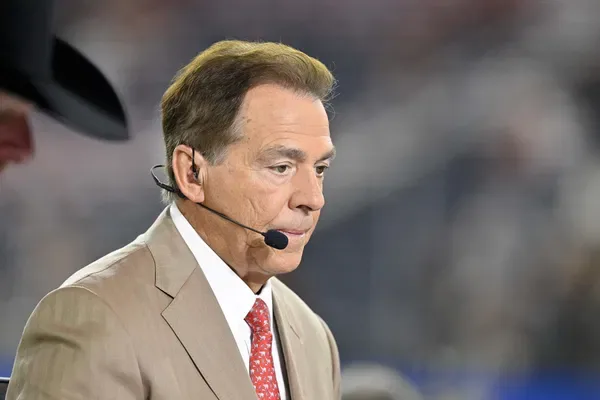Nick Saban saw the storm brewing long before it hit. He warned of the chaos, the lack of regulations, and the inevitable consequences of allowing young athletes to enter the world of big-money NIL (Name, Image, and Likeness) deals without proper guardrails. And now, those warnings have become reality.
The Wild West of NIL isn’t just affecting college football anymore—it’s trickled down to high school, where teenagers with impressive social media followings are being pulled into the money-hungry machine of endorsements, sponsorships, and shady NIL agents. One such player, Baylor commit Taz Williams Jr., has pulled back the curtain, revealing exactly what Saban feared: NIL isn’t just an opportunity—it’s a battleground.
The High School Star Already Cashing In
Taz Williams Jr., a 4-star wide receiver, is no ordinary high school athlete. He’s already secured multiple NIL deals and boasts a massive social media following—19.4K on X (formerly Twitter) and nearly half a million across all platforms. His X handle even spells his last name as “William$,” a clear nod to the financial opportunities coming his way.
But with the flood of money comes an even bigger flood of self-proclaimed NIL experts, middlemen, and so-called agents, all eager to get a piece of the action. And according to his father, Taz Williams Sr., the sharks are circling.
The Dark Reality Behind NIL Deals
In a video shared by Central Texas Sports’ Chad Vautherine, Williams Sr. broke down the brutal truth of the NIL hustle, explaining that followers alone don’t determine a player’s worth—it’s all about negotiation power.
“You can dictate your value by what people want to invest in you. So it’s not really what you’re worth; it’s kind of about what you can negotiate,” he explained.
That’s where things get murky. As Williams Jr.’s brand grew, NIL brokers came knocking, pitching themselves as “liaisons” between athletes and schools. But not all of them had good intentions.
“Anytime there’s money involved, the sharks are gonna come out,” Williams Sr. warned. “They smell blood. And this is such an untapped market—it’s kind of like the Wild West.”
So how do families avoid being scammed? Sports agent and community leader Patrick Arryn offered a simple rule: only work with certified NIL agents.
“Do your research. Google them. See if they’re on LinkedIn. See if they’re affiliated with a real agency,” Arryn advised.
With so many fake agents out there, one wrong move could mean a lost fortune, a ruined reputation, or even NCAA violations.
Ty 🤞🏾🖤 @chadvautherine
Please Help me get to 500k 🙏🏽
👇🏽👇🏽👇🏽👇🏽👇🏽👇🏽👇🏽https://t.co/VEyPKXo4WW pic.twitter.com/RZSPjLWTHq
— 𝑇𝑎𝑧 𝑊𝑖𝑙𝑙𝑖𝑎𝑚$ 𝐽𝑟 (@Taz_1x) February 14, 2025
Nick Saban’s Fears Come True
If there’s one coach who sounded the alarm on NIL dangers, it was Nick Saban.
Last year, Saban—along with Alabama AD Greg Byrne—met with U.S. lawmakers, including Senators Joe Manchin, Tommy Tuberville, and Ted Cruz, to discuss the out-of-control NIL landscape. Tuberville compared it to the Wild West, and Saban didn’t disagree.
“The whole idea of boosters being able to contribute money to collectives established a sort of pay-for-play model, which I don’t think is in the best interest of college athletics in the future,” Saban warned.
Saban believes NIL should be structured differently, with athletes receiving a fair share of revenue—but without turning them into “employees” of their universities.
“I think the number one solution to all this is if we can have some kind of a revenue-sharing proposition that does not make student-athletes employees,” he suggested.
That exact idea is now gaining momentum. The House v. NCAA settlement is set to introduce a revenue-sharing model for student-athletes by 2025, marking a seismic shift in college sports.
A Blueprint for Navigating NIL Chaos
For now, high school and college athletes are left navigating the NIL jungle on their own. But Williams Sr. has one key piece of advice for those looking to avoid the sharks: build a tight inner circle.
“You got to have your trust circle. Whether it’s trainers, coaches, advisors, or mentors, you need a team. And you have to stick with that team.”
With money flowing faster than ever, the stakes have never been higher. The wrong decision could cost an athlete millions—or even their entire career.
The Future of NIL: Will It Be Fixed, or Will the Chaos Continue?
Nick Saban’s warnings weren’t just paranoia—they were a glimpse into the future of college sports.
Now, with high school athletes already facing the same predatory NIL culture that has rocked college football, the question remains:
Will the NCAA and lawmakers finally step in to create a fair, regulated system—or will the Wild West of NIL continue, leaving young athletes to fend for themselves?
For now, one thing is certain: this is just the beginning.
















